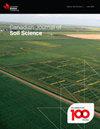Predictive mapping of wetland soil types in the Canadian Prairie Pothole Region using high-resolution digital elevation model terrain derivatives
IF 1.5
4区 农林科学
Q4 SOIL SCIENCE
引用次数: 1
Abstract
Abstract Wetland soil types, which can be distinguished based on calcium carbonate content, vary in their effect on ecosystem functions like phosphorus retention, salinity contributions, and greenhouse gas forcing. These soil types may be predictively mapped with machine learning models that use terrain derivatives calculated from high-resolution digital elevation models. Soil profiles from three Saskatchewan study sites were classified into three functional categories—upland, calcareous wetland, or noncalcareous wetland—and used to train random forest models for predictive soil mapping. Multiple terrain derivatives were included as predictor variables to capture local- and landscape-scale morphometry and hydrology influences, including five derivatives developed for this study. Models were developed at three spatial resolutions: 2, 5, and 10 m, and tested via internal cross-validation and independent validation with datasets from previous studies. Predictive accuracies were highest when mapping at 2 m resolution (independent validation accuracy range = 64%–100%) but also successful when mapping at 5 and 10 m resolutions (independent validation accuracy range = 63%–100%); however, visual inspection determined that the maps generated at 10 m resolution were less detailed and occasionally featured questionable discontinuous soil distributions. Three of the five terrain derivatives developed for this study were among the most important predictor variables (first, second, and 10th most important). Models trained using only data from a specific site had slightly better performance than models trained using data from all sites, except in regions where training data were lacking.利用高分辨率数字高程模型地形衍生物预测加拿大草原坑区湿地土壤类型
湿地土壤类型对磷保持、盐度贡献和温室气体强迫等生态系统功能的影响各不相同,可根据碳酸钙含量进行区分。这些土壤类型可以通过机器学习模型进行预测映射,该模型使用高分辨率数字高程模型计算的地形导数。萨斯喀彻温省三个研究地点的土壤剖面被划分为三个功能类别——高地、钙质湿地和非钙质湿地,并用于训练用于预测土壤制图的随机森林模型。多种地形衍生物被纳入预测变量,以捕获局部和景观尺度的形态计量学和水文影响,其中包括为本研究开发的五个衍生物。在3种空间分辨率下开发模型:2、5和10 m,并通过内部交叉验证和与先前研究数据集的独立验证进行测试。预测精度在2米分辨率下最高(独立验证精度范围= 64%-100%),但在5米和10米分辨率下也成功(独立验证精度范围= 63%-100%);然而,目视检查确定,以10米分辨率生成的地图不太详细,偶尔也有可疑的不连续土壤分布。为本研究开发的五个地形导数中有三个是最重要的预测变量(第一、第二和第十重要)。除了缺乏训练数据的地区外,仅使用来自特定地点的数据训练的模型比使用来自所有地点的数据训练的模型性能稍好。
本文章由计算机程序翻译,如有差异,请以英文原文为准。
求助全文
约1分钟内获得全文
求助全文
来源期刊

Canadian Journal of Soil Science
农林科学-土壤科学
CiteScore
2.90
自引率
11.80%
发文量
73
审稿时长
6.0 months
期刊介绍:
The Canadian Journal of Soil Science is an international peer-reviewed journal published in cooperation with the Canadian Society of Soil Science. The journal publishes original research on the use, management, structure and development of soils and draws from the disciplines of soil science, agrometeorology, ecology, agricultural engineering, environmental science, hydrology, forestry, geology, geography and climatology. Research is published in a number of topic sections including: agrometeorology; ecology, biological processes and plant interactions; composition and chemical processes; physical processes and interfaces; genesis, landscape processes and relationships; contamination and environmental stewardship; and management for agricultural, forestry and urban uses.
 求助内容:
求助内容: 应助结果提醒方式:
应助结果提醒方式:


